A
Auto Express
Guest
Hyundai has opened its order books for the new Santa Fe SUV. Prices start from £40,250 for the entry-level petrol-hybrid model, climbing to £49,010 for the newly introduced flagship plug-in hybrid variant. First deliveries are expected to arrive later this month.
Hyundai has separated the new Santa Fe line-up into two trim-levels: Premium and Ultimate.
Standard equipment for the entry-level Premium model includes 17-inch alloy wheels, automatic LED headlights, LED fog lamps and self-levelling suspension. There are also three new paint finishes to choose from: Glacier White, Taiga Brown and Lagoon Blue.
Inside, the base-model comes with heated leather seats in both the front and rear, dual-zone climate control, a multifunction steering wheel and a wireless phone charger. Buyers also get a 10.25-inch infotainment system, a 4.2-inch digital display set into an analogue gauge cluster and a 10-speaker audio system with an external amplifier and subwoofer.
The Santa Fe also comes with a comprehensive level of safety equipment, which includes lane-keep assist, trailer stabilisation technology and a forward collision avoidance system, which can recognise cars, pedestrians and cyclists. Parking sensors and a rear-facing parking camera come fitted as standard, too.
Prices for Hyundai’s range-topping Santa Fe Ultimate start from £43,815. Upgrades over the base-model include 19-inch alloy wheels, a panoramic glass sunroof, rear window blinds, a 360-degree around-view camera and Hyundai’s semi-autonomous highway drive assist system. Inside, there’s a head-up display and a new 12.3-inch digital instrument cluster.
The Santa Fe Ultimate also gets Hyundai’s remote smart parking assist system, which allows the driver to remotely move the SUV into a tight parking space using the key, without being in the car.
New 2021 Hyundai Santa Fe: engines and drivetrains
The plug-in hybrid Santa Fe’s powertrain comprises a turbocharged 1.6-litre four-cylinder petrol engine, a 90bhp electric motor and a 13.9kWh lithium-ion battery pack. The system has a combined output of 261bhp and 350Nm of torque, which Hyundai says is enough for a 0-62mph time of 8.8 seconds and a top speed of 116mph.
More importantly, the PHEV system gives the Santa Fe a pure-electric range of 36 miles, claimed CO2 emissions of 37g/km and fuel economy of up to 173.7mpg. Prices start from £45,715 in entry-level Premium trim.
Beneath the plug-in, there’s a 227bhp petrol hybrid powertrain, which uses the same 1.6-litre engine, albeit with a less powerful electric motor and a smaller 1.49kWh battery.
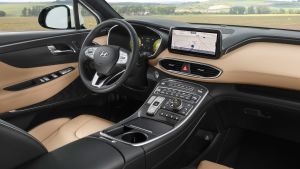
image
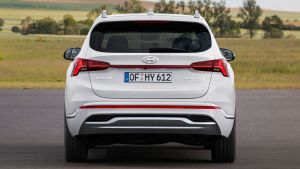
image
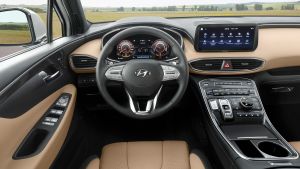
image
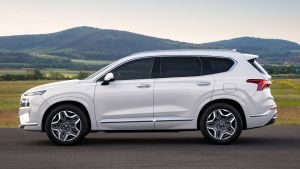
image
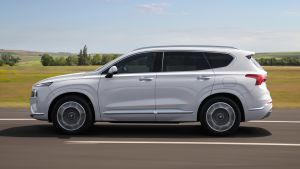
image

image

image
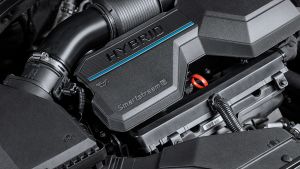
image
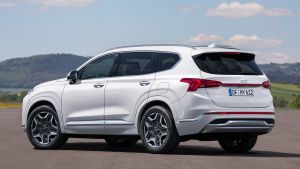
image
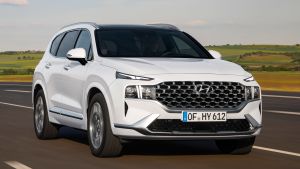
Hyundai Santa Fe
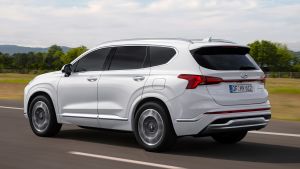
image
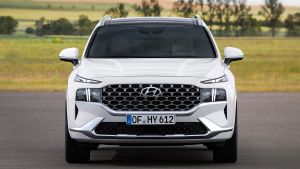
image
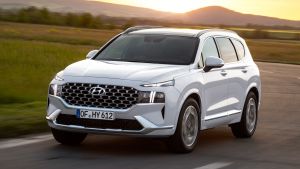
image

image
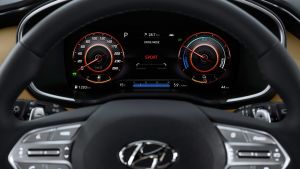
image
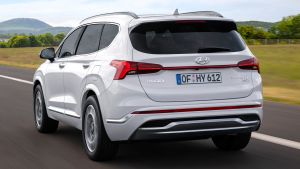
image

image
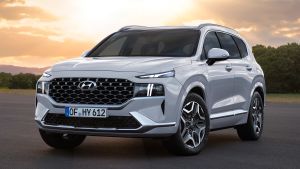
image
Hyundai says the hybrid powertrain will return 44.1mpg, with CO2 emissions of 145g/km. The unit comes as standard with front-wheel drive but, for an extra £2,000, buyers can upgrade to four-wheel drive.
Both hybrid powertrains are hitched to a newly developed six-speed automatic transmission, which Hyundai says is both smoother and more fuel efficient than the previous model’s gearbox. The two engines also feature a new low-pressure exhaust gas recirculation system and continuously variable valve timing, which Hyundai claims improves fuel efficiency by five percent and decreases emissions by 12 percent.
For the first time, Hyundai’s four-wheel drive system is fitted with a terrain mode selector, which offers specific setups for snow, gravel and mud. The drivetrain also comes with three driving modes, called Eco, Comfort and Sport, which can deactivate drive to the rear axle to improve fuel efficiency or distribute the engine’s torque across the SUV’s axles for extra stability, sending either 35 per cent or 50 per cent of the engine’s power to the rear wheels.
European customers can also opt for a new 2.2-litre four-cylinder diesel engine, which produces 199bhp and 440Nm of torque. Unlike the outgoing diesel Santa Fe, this new unit is made mostly from aluminium, which has shaved 19.5kg from the car’s kerb weight. However, Hyundai won’t bring the new engine to Britain
New Hyundai Santa Fe: facelift updates
Hyundai refers to this tweaked Santa Fe as a facelift – but it’s much more than a simple bumper and trim update. It’s actually based on a completely different platform to the outgoing model, with Hyundai adopting the same strategy that Land Rover did with the latest Discovery Sport.
The Santa Fe now shares the same platform as the US- and China-only Sonata saloon, which has added support for Hyundai’s latest chassis technology and interior equipment.

image

image

image

image

image

image

image

image

image

Hyundai Santa Fe

image

image

image

image

image

image

image

image
Hyundai says its upgraded underpinnings give the new Santa Fe better handling and improved crash safety, thanks to its extensive use of high-tensile steel and its redesigned crumple zones. Refinement should be improved, too, with Hyundai fitting additional sound dampening in vibration-sensitive areas such as the engine bay and suspension towers
Due to the platform switch, the Santa Fe has also increased in size. It’s 15mm longer, 10mm wider and 5mm taller than the model it replaces, with dimensions of 4,785mm, 1,900mm and 1,685mm respectively. Hyundai says this has unlocked more space in the cabin for passengers, adding an extra 34mm of legroom for rear-seat occupants.
Hyundai has given the Santa Fe a substantial cosmetic update as part of its rethink, with new T-shaped LED daytime running lights, a redesigned radiator grille, a pair of subtly tweaked bumpers, wider wheel arches and a new, full-width rear LED light bar.
Inside, there’s also a new floating centre console, a new gear selector and a number of extra storage bins. The infotainment system and gauge cluster are also new, with the latter offering wireless support for Apple CarPlay, and Android Auto.
Now read all the latest news on the pure-electric Hyundai Ioniq 5. Let us know your thoughts in the comments section below…
Continue reading...
Hyundai has separated the new Santa Fe line-up into two trim-levels: Premium and Ultimate.
Standard equipment for the entry-level Premium model includes 17-inch alloy wheels, automatic LED headlights, LED fog lamps and self-levelling suspension. There are also three new paint finishes to choose from: Glacier White, Taiga Brown and Lagoon Blue.
- SEE MORE Best hybrid SUVs 2021
Inside, the base-model comes with heated leather seats in both the front and rear, dual-zone climate control, a multifunction steering wheel and a wireless phone charger. Buyers also get a 10.25-inch infotainment system, a 4.2-inch digital display set into an analogue gauge cluster and a 10-speaker audio system with an external amplifier and subwoofer.
The Santa Fe also comes with a comprehensive level of safety equipment, which includes lane-keep assist, trailer stabilisation technology and a forward collision avoidance system, which can recognise cars, pedestrians and cyclists. Parking sensors and a rear-facing parking camera come fitted as standard, too.
Prices for Hyundai’s range-topping Santa Fe Ultimate start from £43,815. Upgrades over the base-model include 19-inch alloy wheels, a panoramic glass sunroof, rear window blinds, a 360-degree around-view camera and Hyundai’s semi-autonomous highway drive assist system. Inside, there’s a head-up display and a new 12.3-inch digital instrument cluster.
The Santa Fe Ultimate also gets Hyundai’s remote smart parking assist system, which allows the driver to remotely move the SUV into a tight parking space using the key, without being in the car.
New 2021 Hyundai Santa Fe: engines and drivetrains
The plug-in hybrid Santa Fe’s powertrain comprises a turbocharged 1.6-litre four-cylinder petrol engine, a 90bhp electric motor and a 13.9kWh lithium-ion battery pack. The system has a combined output of 261bhp and 350Nm of torque, which Hyundai says is enough for a 0-62mph time of 8.8 seconds and a top speed of 116mph.
More importantly, the PHEV system gives the Santa Fe a pure-electric range of 36 miles, claimed CO2 emissions of 37g/km and fuel economy of up to 173.7mpg. Prices start from £45,715 in entry-level Premium trim.
Beneath the plug-in, there’s a 227bhp petrol hybrid powertrain, which uses the same 1.6-litre engine, albeit with a less powerful electric motor and a smaller 1.49kWh battery.

image

image

image

image

image

image

image

image

image

Hyundai Santa Fe

image

image

image

image

image

image

image

image
Hyundai says the hybrid powertrain will return 44.1mpg, with CO2 emissions of 145g/km. The unit comes as standard with front-wheel drive but, for an extra £2,000, buyers can upgrade to four-wheel drive.
Both hybrid powertrains are hitched to a newly developed six-speed automatic transmission, which Hyundai says is both smoother and more fuel efficient than the previous model’s gearbox. The two engines also feature a new low-pressure exhaust gas recirculation system and continuously variable valve timing, which Hyundai claims improves fuel efficiency by five percent and decreases emissions by 12 percent.
For the first time, Hyundai’s four-wheel drive system is fitted with a terrain mode selector, which offers specific setups for snow, gravel and mud. The drivetrain also comes with three driving modes, called Eco, Comfort and Sport, which can deactivate drive to the rear axle to improve fuel efficiency or distribute the engine’s torque across the SUV’s axles for extra stability, sending either 35 per cent or 50 per cent of the engine’s power to the rear wheels.
European customers can also opt for a new 2.2-litre four-cylinder diesel engine, which produces 199bhp and 440Nm of torque. Unlike the outgoing diesel Santa Fe, this new unit is made mostly from aluminium, which has shaved 19.5kg from the car’s kerb weight. However, Hyundai won’t bring the new engine to Britain
New Hyundai Santa Fe: facelift updates
Hyundai refers to this tweaked Santa Fe as a facelift – but it’s much more than a simple bumper and trim update. It’s actually based on a completely different platform to the outgoing model, with Hyundai adopting the same strategy that Land Rover did with the latest Discovery Sport.
The Santa Fe now shares the same platform as the US- and China-only Sonata saloon, which has added support for Hyundai’s latest chassis technology and interior equipment.

image

image

image

image

image

image

image

image

image

Hyundai Santa Fe

image

image

image

image

image

image

image

image
Hyundai says its upgraded underpinnings give the new Santa Fe better handling and improved crash safety, thanks to its extensive use of high-tensile steel and its redesigned crumple zones. Refinement should be improved, too, with Hyundai fitting additional sound dampening in vibration-sensitive areas such as the engine bay and suspension towers
Due to the platform switch, the Santa Fe has also increased in size. It’s 15mm longer, 10mm wider and 5mm taller than the model it replaces, with dimensions of 4,785mm, 1,900mm and 1,685mm respectively. Hyundai says this has unlocked more space in the cabin for passengers, adding an extra 34mm of legroom for rear-seat occupants.
Hyundai has given the Santa Fe a substantial cosmetic update as part of its rethink, with new T-shaped LED daytime running lights, a redesigned radiator grille, a pair of subtly tweaked bumpers, wider wheel arches and a new, full-width rear LED light bar.
Inside, there’s also a new floating centre console, a new gear selector and a number of extra storage bins. The infotainment system and gauge cluster are also new, with the latter offering wireless support for Apple CarPlay, and Android Auto.
Now read all the latest news on the pure-electric Hyundai Ioniq 5. Let us know your thoughts in the comments section below…
Continue reading...
